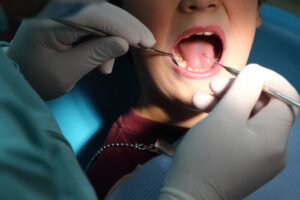Early Orthodontic Treatment

Early Orthodontic Treatment
The main purpose of orthodontic therapy is to prevent and remedy "bite" problems. Such anomalies may be caused by a variety of things, including genetics, early tooth loss in children, and bad oral habits (such as thumb sucking) and developmental issues.
Orthodontic deviations might be present from birth or appear in toddlerhood or the early years of development. Straight teeth can reduce the incidence of dental decay and childhood periodontal disease, but crooked teeth lower self-esteem and make good oral hygiene challenging.
Your child's pediatric dentist can evaluate orthodontic anomalies and, if necessary, perform early intervention techniques during biannual preventative checkups. Before the age of eight, children should receive their first orthodontic assessment.
Why is it a good idea to start orthodontic treatment early?
Some kids exhibit subtle orthodontic anomalies in their early development. Your child's pediatric dentist may decide to watch the problem develop over time without taking any action in such situations.
Early orthodontic treatment, however, can offer a number of advantages for kids who have significant orthodontic abnormalities, including:
- improved visual appeal and self-confidence
- increased likelihood of healthy jaw developmentincreased possibility of adult teeth with ideal spacing and alignment
- decreased likelihood of bruxism (tooth grinding)
- decreased chance of tooth decay
- periodontal disease, and cavities in children
- decreased chance of adult teeth getting impacted
- decreased likelihood of lengthy orthodontic treatments in the future
- decreased possibility of speech issuesdecreased chance of tooth
- gum, and jawbone damage.
When is the right time for my child to start early orthodontics?
Three age-related stages of orthodontic therapy are recognized by pediatric dentists. Below is a detailed description of these phases.Early intervention (stage 1, 2–6 years old)The goal of early orthodontic therapy is to direct and control how wide both tooth arches should be.
Early treatment's primary objective is to create enough space for the permanent teeth to erupt properly. Children who have trouble biting properly, youngsters who lose their baby teeth at a young age, bruxers, youngsters whose jaws click or grind while moving, and youngsters who breathe through their mouths alone rather than their nose and mouth are all good candidates for early treatment.
Early treatment involves working with parents and kids to get rid of habits that can affect orthodontics, including thumb sucking and excessive pacifier use. A number of dental appliances may also be given by the dentist to encourage jaw development, hold space for adult teeth (space maintainers), or stop teeth from "shifting" into undesirable positions.
Middle dentition (6–12 years old) is stage two.Treatments for the middle dentition aim to gradually straighten misaligned permanent teeth, realign misaligned jaws, and begin to repair crossbites. The middle dentition denotes a stage of development during which both the soft and hard tissues are remarkably malleable. Therefore, in some aspects, it indicates the ideal time to start correcting a severe malocclusion.Once more, the dentist might give the child a dental device. There are fixed appliances (like braces) and removable appliances.
The youngster will be able to speak, eat, and chew normally regardless of the appliance. However, in order to lower the danger of discoloration, decay, and subsequent cosmetic damage, children who have fixed dental equipment should take special care to clean the entire mouth region every day.
Stage 3: Teenage dentition (13 years of age or older)Most parents automatically think of orthodontic treatment when they think about their child's adolescent dentition. The permanent teeth's alignment and the smile's aesthetic appeal are two of the key objectives of teenage dentistry.
The dentist will typically offer permanent or removable "braces" at this time to gradually straighten the teeth. The adolescent may be required to wear a retainer after completing orthodontic treatment to prevent the teeth from shifting back to their original position.








